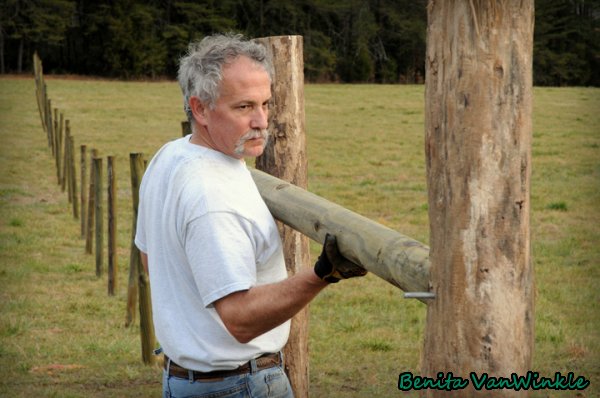Fencing

Fencing
 The first farm improvement every prospective alpaca owner should think of is fencing. Before the barn, before water sources or anything; the need to contain the herd and to thwart predators needs to be addressed first. Fortunately, fencing is simple – unfortunately it is also expensive. But if you are willing to do it yourself, you can save significant amounts of money while acquiring equipment you need for future operations.
The first farm improvement every prospective alpaca owner should think of is fencing. Before the barn, before water sources or anything; the need to contain the herd and to thwart predators needs to be addressed first. Fortunately, fencing is simple – unfortunately it is also expensive. But if you are willing to do it yourself, you can save significant amounts of money while acquiring equipment you need for future operations.
For initial planning purposes, a good rule of thumb is 2,000′ of fence for every 5 acres, regardless of what shape the outline of the pasture takes (unless your pasture has a very complex shape). You can use that for initial planning and budgeting. This rule of thumb does not account for cross fencing, by the way. Of course, you’ll eventually need to walk the actual proposed fence line to measure, check drainage, and to review the topography. But until then, this rule of thumb works well. As for equipment, you’ll need to rent a tractor with auger, or a skid steer (“Bobcat”) with auger, or either of them with a post driver. I purchased a used tractor and a used post driver myself, so I could have this equipment for later usage. All the other tools you’ll need are fairly common ones that you can beg, borrow, buy, or make.
For my 5 acre fence, I needed 189 line posts, 16 bracing poles, 20 sturdier posts for corner and mid-line bracing posts and I broke 4 line posts with the post driver. That was a total of 229 posts. I used 9′ tall, 6″ in diameter, pressure treated posts for the line posts and the corner posts were 8-10 inch locust posts. Locust is naturally rot-resistant and fairly common in my area of the southeast. I used Red Branch non-climb Horse fence. Some folks use four foot fence and then add a top electric wire or barb wire one foot above that to save on cost since 4′ fencing is a good bit cheaper than 5′ fencing. This is your call and both methods are perfectly fine. We have farm visitors and I don’t like the liability of electric or barb wire so I used 5′ fencing.
As for fence building itself, I can’t cover all the details here in a blog. Plus, there are great installation videos on YouTube and on RedBrand.com, the web site of my favorite brand of fencing. However, there is one thing I never see discussed anywhere so I’ll cover it here: Should you dig holes for the posts or drive them in with a post driver? While this is my first experience with Alpacas, I have built fences before. I’ve dug A LOT of holes with PTO driven augers and by hand. I used a post driver (for the first time) for this fence, and I will never dig a hole again. My post driver cut the amount of work in half and created posts much, much stronger and sturdier.
Specifically, I bought a used Shaver HD-8 post driver on Craigslist for not much more than a used auger (about $1200 vs $600) . The only possible down side is they require remote hydraulics to operate. Most folks with tractors built after the mid-1970s or so will more than likely have remote hydraulics; or you can rent a tractor with remote hydraulics. But those of us with older tractors usually have to retrofit hydraulics to the tractor. Adding remote hydraulics was not too hard in my case, but might be a deal breaker in your case if you are not mechanically inclined.
In short, every fence installation is unique, and all fence projects are constrained by the equipment and material available in your area. The work is hard, but rewarding. It is a great way to save money, or do as I did: Use the savings as a way to acquire a tractor for your future operations. Good luck with your fence and let us know how your fence project goes.
Spencer